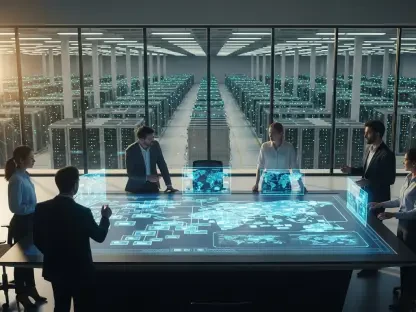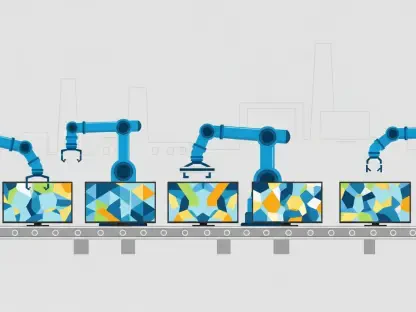In an era where artificial intelligence is reshaping industries at an unprecedented pace, the demand for robust, scalable data center infrastructure has never been more critical, especially as machine learning and cloud computing workloads continue to surge globally. A groundbreaking partnership between a leading Korean telecommunications giant and a global leader in energy management and automation is stepping up to meet this challenge head-on. Their collaboration focuses on advancing artificial intelligence data centers (AIDCs) through innovative technology and strategic alliances. This development signals a significant shift in how infrastructure can support the ever-growing needs of AI applications. By combining expertise in telecommunications and energy solutions, the two companies are setting a new benchmark for efficiency and sustainability in data center operations, starting with a flagship project in South Korea that promises to redefine industry standards.
Pioneering AI Infrastructure in South Korea
The collaboration has taken a major leap forward with an integrated procurement agreement for the construction of an AIDC in Ulsan, South Korea, marking a tangible milestone in the joint efforts of these industry leaders. This facility represents a cornerstone of a broader strategy to enhance AI capabilities through cutting-edge infrastructure. Schneider Electric, renowned for its expertise in energy management, is supplying critical mechanical, electrical, and plumbing (MEP) systems for the Ulsan project. These systems encompass five essential categories, including switchgear, uninterruptible power supply (UPS), and automated control solutions, ensuring a reliable foundation for high-performance operations. The agreement highlights a shared vision of leveraging advanced technology to address the complex demands of AI workloads, positioning the Ulsan AIDC as a potential model for future developments in the sector.
Beyond the hardware, a key innovation in this partnership lies in the integration of digital tools to optimize data center performance. Schneider Electric’s Electrical Transient Analyzer Program (ETAP), a sophisticated digital twin software for power systems, is being embedded into the AI Data Center Infrastructure Management (DCIM) platform. This integration enables real-time monitoring and optimization of power usage, significantly enhancing operational efficiency. Such technological synergy reflects a commitment to sustainability alongside performance, ensuring that energy consumption aligns with environmental goals. As AI applications continue to expand, this focus on efficient power management could serve as a blueprint for data centers worldwide, demonstrating how digital solutions can transform traditional infrastructure challenges into opportunities for growth.
Expanding Collaboration Across Industries
The scope of this alliance extends far beyond a single project, with a new Memorandum of Understanding (MoU) broadening cooperation to include other affiliates within the SK Group conglomerate. This expanded partnership explores joint initiatives in areas such as UPS and energy storage systems, incorporating advanced lithium-ion battery technology to bolster energy reliability. Additionally, efforts to coordinate MEP demand across the group aim to create synergies that drive mutual growth and innovation. This strategic alignment emphasizes a balance between self-reliance and collaboration, a core principle guiding the overarching AI strategy. By fostering such cross-industry cooperation, the partnership is poised to address diverse infrastructure needs while amplifying its impact on the tech ecosystem.
Another dimension of this expanded collaboration is the development of forward-thinking solutions to streamline data center construction and operation. Both companies are working on reference designs and prefabricated solutions to reduce build times, alongside exploring Energy-as-a-Service (EaaS) offerings to provide flexible energy management options. These initiatives reflect an acute awareness of the industry’s pressing need for speed and adaptability in meeting AI-driven demands. As data centers become increasingly integral to global technology frameworks, such innovative approaches could redefine how quickly and efficiently new facilities come online. The focus on scalability and adaptability underscores a proactive stance in tackling the evolving challenges of modern infrastructure.
Driving Growth in the AI Business Landscape
Recent financial performance underscores the momentum behind this partnership, with the telecommunications partner reporting a 13.9% year-over-year increase in AI business revenue during the second quarter. Specifically, the AIDC segment saw a 13.3% growth, fueled by improved utilization rates, while the AI Transformation (AIX) business surged by 15.3%, reaching substantial revenue figures. Once operational, the Ulsan AIDC, combined with an existing facility in Seoul, will elevate total data center capacity to over 300 MW, a significant step toward ambitious targets. Projections indicate that annual AIDC revenue could surpass KRW 1 trillion by 2030, highlighting the long-term vision driving these initiatives. This growth trajectory positions the company as a frontrunner in South Korea’s AI infrastructure landscape.
Further bolstering this position is the recent launch of a sovereign GPU-as-a-Service (GPUaaS) platform powered by over 1,000 high-performance GPUs. This cutting-edge offering caters to the escalating demand for computational power in AI applications, reinforcing leadership in the region’s tech sector. The platform exemplifies a commitment to staying at the forefront of innovation, ensuring that businesses and developers have access to the tools necessary for advanced AI development. As the industry continues to evolve, such initiatives highlight the importance of robust infrastructure in supporting next-generation technologies. This strategic focus not only drives revenue growth but also cements a reputation for pioneering solutions in a competitive global market.
Shaping the Future of AI Data Centers
Reflecting on the strides made through this alliance, the collaboration between these two industry titans laid a strong foundation with the Ulsan AIDC project, integrating advanced MEP systems and digital twin technology for unparalleled efficiency. The partnership’s expansion across affiliated entities and its alignment with impressive AI business growth metrics showcased a comprehensive approach to innovation. By addressing both immediate infrastructure needs and long-term industry trends, the joint efforts established a precedent for how cross-sector expertise could tackle the complexities of AI workloads. The initiatives undertaken marked a pivotal moment in redefining data center standards, with a clear emphasis on sustainability and scalability.
Looking ahead, the focus should shift to scaling these innovations globally, adapting the Ulsan model to diverse markets with unique energy and computational demands. Stakeholders might consider investing in further research to refine digital twin applications, ensuring they remain agile in dynamic tech environments. Exploring additional partnerships could also amplify impact, bringing in complementary expertise to address emerging challenges. As the demand for AI infrastructure continues to grow, the lessons learned from this collaboration offer valuable insights for building resilient, efficient data centers that power the future of technology.









